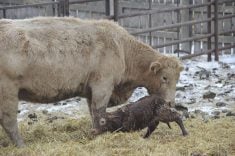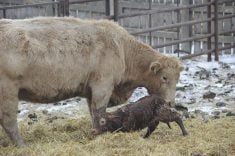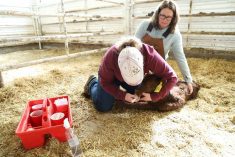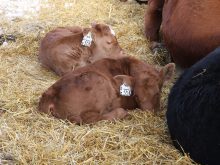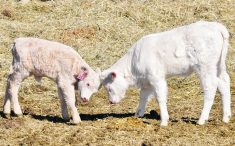With calving season in full swing, ensuring calves are primed to thrive is top of mind.
When refreshing themselves on indicators of good health in calves, producers are encouraged to remember to trust in their knowledge of their own herd and to stay vigilant in monitoring them.
“Early detection is always going to be key for any type of illness,” said Dr. Carling Matejka with Veterinary Agri-Health Services in Crossfield, Alta.
Read Also

Beef cattle more prone to trace mineral deficiencies
The trace mineral status of our cows and calves is a significant challenge for western Canadian producers and veterinarians.
“You know your cows best, you know your calves best, so if you see anything out of the norm, just try to investigate it a little bit further.”
Preparing a calf for a healthy life begins before calving. Cows should be up to date on vaccinations to provide protection for their calf in utero and build adequate antibodies in their colostrum.
A body condition score of 3.5 out of five is recommended for cows about to calve to help prevent difficult calvings, metabolic issues and poor-quality colostrum.
Colostrum intake is always the top priority in caring for a newborn calf.
“Calves need to receive at least two to four litres of high-quality colostrum within the first four hours after birth, followed by another two litres within eight to 12 hours,” said Matejka.
“This colostrum is what’s going to provide them with their essential immunity for the first couple weeks of life.”
Difficult calvings can lead to calves not consuming the colostrum they require, so they may need to be supplemented. The quality of colostrum produced by heifers can sometimes be lower than that of mature females, also requiring supplementation for their calves.
If a calf requires additional colostrum, producers need to be sure to use the highest quality possible, whether it’s from females on their operation or providers such as the Saskatchewan Colostrum Company.
“It’s really important not to use colostrum from other farms because they’re not going to have the same antibodies for the diseases that are present on your farm, as well as there’s a risk for them to bring disease onto your farm.”
Other factors that help a newborn calf thrive include:
Calving in a clean environment, free of manure to reduce the risk of disease transfer.
Regulating the temperature in calves born in cold conditions.
Frequent monitoring to ensure each calf is nursing regularly and looks alert and active.
Alertness and activity are important indicators of a calf’s health, and signs of lethargy are cause for concern.
“We know what a normal calf should look like. They should be up, usually within an hour of calving. After that, once they’re a couple days old, they’re generally pretty lively,” said Matejka.
Nursing behaviour and suckle reflex are also important to watch for in calves.
“If that suckle reflex starts to decrease or is completely absent, then those are definitely going to be some red flags for further investigation,” she said.
Other indicators to watch for in the first few days include hydration status — gaunt-looking calves and those with sunken eyes may require electrolytes to help rehydrate them — and respiration, including signs of abnormal breathing, pneumonia and congenital issues.
While weight benchmarks vary by breed, genetics and nutrition, birth weight for calves should generally range from 60 to 110 pounds.
Average daily gain, Matejka said, is a better variable to monitor. Pre-weaning, calves should be gaining about 1.5 lb. per day.
“A good benchmark to look at would be at two months old, we want calves to have doubled their birth weight,” she said.
At weaning, calves should fall in the range of 500 to 700 lb.
“Cows should be weaning calves that are 40 per cent of their dam’s mature weight, so this would mean that a 1,500 lb. cow should wean a calf that’s around 600 lb.”
Many of the signs described above remain important indicators of health as calves progress toward weaning time.
“If they’re still on their dam’s side, we want to make sure that they’re healthy and thriving,” said Matejka.
“There’s no signs of illness, no coughing, nasal discharge, diarrhea, lameness. We want to make sure that they’re active, playful and responsive, and that they’ve had good growth and development.”
To thrive post weaning, calves need to be up to date on all their vaccines and have a body condition score of three out of five.
As well, note how individuals compare to the overall group of calves.
“Looking at that group as a whole is going to give you a really good indicator because those calves are all exposed to the same nutrition and stimuli and environmental conditions,” she said.
“If you see some that are standing out and looking a little bit different, that might be a bit of a sign that they’re not going to thrive as well moving forward.”




